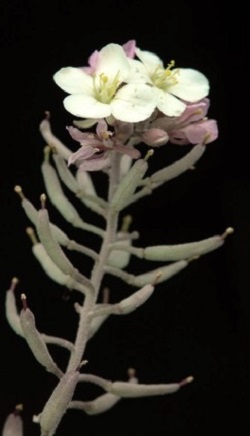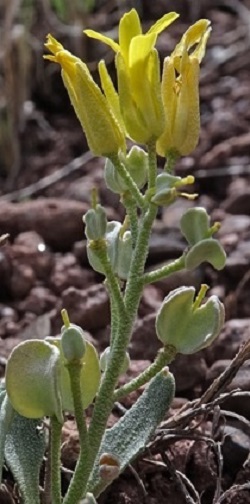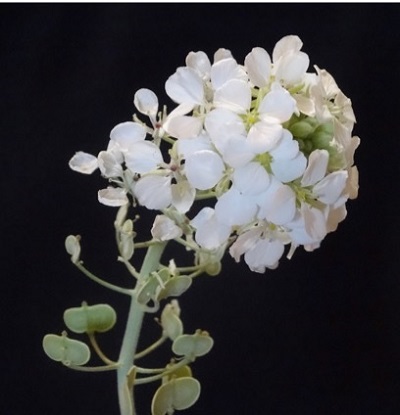 Bicolor Fanmustard (Nerisyrenia camporum)
Bicolor Fanmustard (Nerisyrenia camporum)
Photo credit: Sara Fuentes-SorianoAt the meeting of the Gila Native Plant Society on Friday, January 19, 2018, Sara Fuentes-Soriano, plant scientist, will present a talk entitled "The intriguing and wonderful natural history of uncommon Southwestern mustards". As she explains, " Members of the mustard family (Brassicaceae) are well known for the unique flavor they bring to our table. The plant diversity of the family is organized within 41 subgroups known as tribes. Tribe Physarieae is a unique group of mustards with specialized pollen morphology and a natural history tied to the Southwest region of North America. In this talk we will visit different geographic areas where this tribe is found, cover some useful morphological and molecular features that help us to recognize species, and learn about a few species that are locally and traditionally used for medicinal purposes."
 Newberry's Twinpod (Physaria newberryi)
Newberry's Twinpod (Physaria newberryi)
Photo credit: Sara Fuentes-Soriano Spectacle Pod (Dimorphocarpa wislizeni)
Spectacle Pod (Dimorphocarpa wislizeni)
Photo credit: Sara Fuentes-SorianoA native of Mexico, Sara Fuentes-Soriano obtained undergraduate and graduate degrees in biology and electron microscopy at the national university of Mexico (UNAM) and completed her studies with a Ph.D. in Plant Systematics and Evolution from the University of Missouri - Saint Louis.
In her research, she uses plant museum collections and data to address fundamental questions related to trait evolution, taxonomic classification and phylogenetics. Most recently, her research on the comparative phylogenomics of several crop species and their wild relatives (e.g., loblolly pine, cacao, sweet potato) has been shared with a broad community through publications and outreach programs. The aim is to provide research-based biotechnology solutions to agricultural problems identified by economically disadvantaged farmers, rural communities, and cattle ranchers.
Currently, she serves as the Director and Curator of the two herbaria on the New Mexico State University campus. Some of her most important duties are carrying out: 1) professional hands-on experiences designed to engage students to learn more about biological sciences and natural history collections; 2) programs to recruit, train and mentor students and volunteers in herbarium work; 3) activities to promote research and the use of herbarium specimens by the broader plant science community; 4) herbarium tours and botanical presentations to stakeholders inside and outside campus; 5) plant identification services for users of the NMSU herbaria and the University's Plant Diagnostic Clinic.
Sara explains, "I have a strong commitment to higher education and expanding representation in the STEM fields. NMSU, an official Hispanic Serving Institution (HSI) located ca. 50 miles from the Mexican border, provides me, as a Mexican female scientist, the wonderful opportunity to educate and raise awareness about plant science within under-represented, economically disadvantaged sectors of the community." Since joining NMSU, she has participated in the College Assistance Migrant Program, offering professional hands-on experience to first-generation college students in plant biology using herbarium-based knowledge.
Meetings of the Gila Native Plant Society are held the third Friday of the month at 7.00 p.m. in Harlan Hall, second floor, Room 219, corner of Alabama and 12th Streets, on the Western New Mexico University campus. Free and open to the public. Refreshments following the program.
The Gila Native Plant Society is committed to promoting education, research and appreciation of the native flora of the Southwest, encouraging the preservation of rare and endangered plant species and supporting the use of suitable native plants in landscaping. For information on programs, publications and membership, please visit www.gilanps.org.